Family Coat of Arms ~ Part of an early roll of arms belonging to the Society of Antiquaries of London
On yesterday’s Heraldry post, I began sharing the introduction to W. H. St. John Hope’s 1913 book, Heraldry for Craftsmen and Designers. I’m going to continue today with the section about the designs and devices that appear on a coat of arms. Note: I’ve added some of my own notations in the text between brackets when I didn’t understand what the author was referring to. I got my additional information from this excellent article Coat of Arms at Wikipedia.
Mr. St. John Hope writes:
In the formation of arms the mere combinations of colours and metals produced by vertical, horizontal, or other divisions of the shield were soon exhausted, as were quarters, checkers, etc. There accordingly grew quite naturally the further use of applied strips or bands based upon such divisions.
Coat of Arms Templates
Thus the vertical parting of a metal and a colour known as party [see image above] produced the pale, and a horizontal division the fesse or bar, and these combined to form the cross suggested by the quarterlines. An oblique or slanting parting gave rise to the bend, and the crossing of two such produced the St. Andrew’s cross or saltire. A combination of the lines of a saltire with a quarterly division produced the varied field called gyronny. The border almost suggested itself. See image below.
Blank Coat of Arms
A cutting off of the upper half or head of the shield yielded the chief, and of the fourth part the quarter. One other of these applied pieces, or ordinaries [a simple geometrical figure, bounded by straight lines and running from side to side or top to bottom of the shield] as they were called, was the cheveron, formed of two strips issuing from the lower edges of the shield and meeting in a point in the middle, like the cheverons forming the roof timbers of a house. Another ordinary was the pile, which was often threefold with lines converging towards the base. See below.
Printable Coat of Arms
Sometimes a shield was charged [making use of any emblem or device occupying the field of a shield] with one of a smaller size called a scutcheon, and the middle of this was occasionally cut out to form a voided scutcheon or orle. Flanches, as they are called, are very rarely found; they were formed by drawing in-curving lines within each side of the shield.
An even series of pales yielded a vertical striping called paly, and of piles, pily, while an even number of bars became barry. Undulated or waved bars formed wavy, and sometimes paly and pily stripes were also waved. See below. In early examples the bend was often bended or curved. Bends were so represented in one of the shields in Westminster Abbey, in some of the shields over the nave arcades in York minster, and a number of monumental effigies. A narrower bend which overlaid everything was known as a baston. A number of narrow bends produced a bendy, but the lines were then straight. A field divided into squares or checkers formed checky, and when it divided into what are now called lozenges it became lozengy. See below.
Shield Templates
Pales, fesses, crosses, saltires, borders, and cheverons sometimes had their edges engrailed by taking out of them, as it were, a continuous series of bites separated by sharp points, and the lower edge of a chief or the inner margin of a border was often indented like the edge of a saw; but in early heraldry engrailing and indenting were interchangeable terms. An indented fesse was anciently called a daunce. Cheverons, fesses, bars, etc. were occasionally battled, through the upper line being formed into battlements. A fesse was often placed between two cheverons, as in the well-known arms of FitzWalter; or between two very narrow bars called cotises, or pairs of cotises called gemell bars. Cheverons, bends, and pales were also sometimes cotised. Cotises were often of a tincture different from that of the ordinary which they accompanied, and sometimes indented or dancetty as in the arms of Clopton and Gonvile. The ground or field could be relieved by the use of vair or ermine, or by the addition of fretting or trellis work or other simple means. It was also not unfrequently powdered with small crosses, fleurs-de-li, or billets; often in conjunction with a larger charge like a cinqfoil or a lion.
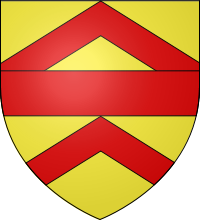
FitzWalter Coat of Arms
FitzWalter Coat of Arms with Cheverons and Fesse from Wikimedia Commons
Almost from the beginning every kind of device [coat of arms] was charged or painted upon shields, either singly or in multiple, and upon or about such ordinaries as crosses, cheverons, and fesses. Birds, beasts, and fishes, and parts of them, like heads, or feet, or wings; flowers, fruits, and leaves; suns, moons or crescents, and stars; fleurs-de-lis, crosses, billets, roundels, rings, etc. all were pressed into service. The great rule as to colour held good as regards charges, and it was not permissible to paint a red rose upon blue or a gold star upon silver; but a red rose upon gold or a silver star upon blue was quite right.
It has however been lawful at all times to place an ordinary, such as a fesse or a cheveron, and whether charged or not, upon a parti-coloured field like quarterly, checky, paly or barry, or upon vair or vairy. A quarter or a chief, or a border without reference to its colour, can also be added to any such field.
Conversely, a parti-coloured cross, fesse, or charge of any kind, is allowable upon a plain field.
Wow! It’s like trying to learn another language! Can you imagine the skill it took for craftsmen to design a coat of arms?
To be continued . . .

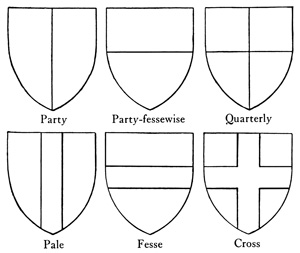
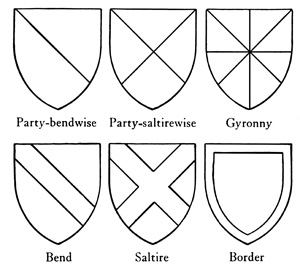
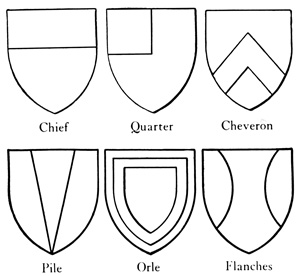
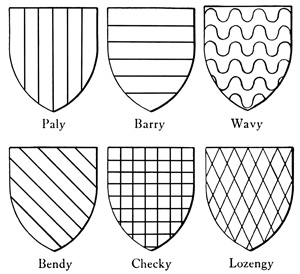
5 thoughts on “Coat of Arms”